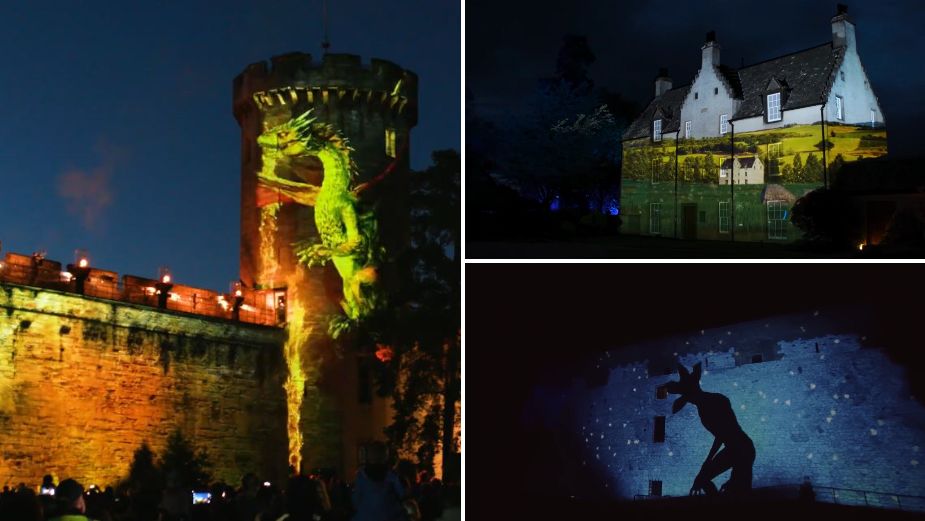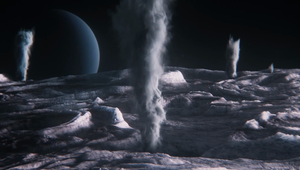
Scaling Up Sound: Crafting Audio for Projections

To continue delighting, enticing, and surprising audiences, brands need to think outside the box - or outside of the standard screens - when it comes to their campaigns and activations. Why limit creativity to a phone or TV screen when anything could be your canvas? It might sound somewhat far-fetched but that’s exactly what projections do. With the use of a technique called ‘projection mapping’ - which sees images mapped onto any manner of surfaces - objects like castles, rock faces, and even water, become the canvas on which to paint with light.
The visuals take centre stage, but music and sound are used to give them shape, help communicate the scale and magnitude of what’s being displayed and, most importantly, bring the narrative - and therefore the whole experience - to life.
LBB spoke to Ed de Lacy, sound designer at Clearcut Sound Studios, about the craft behind sound for projections and the challenges of working on projects of this scale. Their strong relationship with Pixel Artworks has led to the two companies working together on many brilliant projects, all of which are so varied and diverse that they each require a very different creative approach.
Stranger Things, Season 4 Promo
The spectacle of Stranger Things has evolved from season to season, with millions tuning in to Netflix to get their fix of addictive science fiction fuelled by ‘80s nostalgia. To promote season four - the show’s biggest yet - the marketing had to make an equivalent mark. The idea was to create projections to be shown simultaneously across different European cities depicting the opening of a gate to the Upside Down. “The sound brief for this was very much in keeping with the show - dark, dramatic. The music and a lot of the sound design elements were supplied beforehand and I was tasked with using them respectfully and effectively. The projection from Pixel Artworks was almost completely original however and therefore also needed plenty of additional sound design. This absolutely had to be in keeping with and at the same high level as the TV show,” says Ed.
The projection was a teaser of what was to come in the new season, featuring atmospheric dialogue from Dustin (played by Gaten Matarazzo) and a preview of the monsters waiting in the Upside Down. “One of the tricks with the sound design was making it edgy and intriguing but not so terrifying that people would be turned off.” The show’s directors, the Duffer brothers, are famously protective of all the elements surrounding the show, with this being no exception. To ensure that all the elements of the projection were done to as high of a standard as the show, they personally signed off on each element themselves - they thankfully gave Ed the thumbs up. Projected onto Wawel Castle in Krakow, Ed knew that the projection needed to make a huge impact sound-wise; it crackled and hissed, illustrating aurally the darkness of the Upside Down trying to break through. “I scaled up the sounds, made them really big and impactful to match the scope of the visuals, mirroring the atmosphere of the show.”
The Macallan Scotch Whisky
The projection for The Macallan was a real spectacle - coming in at nearly twenty minutes long - celebrating the launch of their new distillery on-site. The brand invited a whole host of VIPs to the launch with the aim of communicating the brand’s storied history, ethos, and luxurious status. Hundreds of years of the brand’s history was projected onto the side of Easter Elchies House, making it look like the walls could move. The show needed bespoke music and Ed composed original work to help narrate the story of the brand. “The music started quite traditionally, with classical elements, then it shifted to its middle part, guiding people as they walked from the historical building to the new, futuristic distillery. There, they were treated to a huge projection and a light display. The music for that part was bombastic, loud, energetic yet retaining the original theme of the first movement,” explains Ed.
“Working on this was challenging and exciting at the same time. Creating something that long was complex but the music was extremely enjoyable to compose. Having license to incorporate some brash, in-your-face sounds for the finale was a real high point. Overall, there was a lot of sound design to support the music and tell the story, plus we recorded voiceover as well, featuring a poem written by the former Scottish poet laureate for the final sound too. The mix had to be spot on to translate outdoors as the audience moved from one place to another.” Ed worked in tandem with the visuals’ designer, Sean Lamonby, to ensure that the two were perfectly matched, creating maximum impact for the eyes and the ears. “The sound was fully integrated into, and informed by, the visuals. It was a key element from start to finish, working in complete synergy with the final projection,” Ed adds.
Warwick Castle: Dragon Slayer
Projections are also a way to bring well-known and loved landmarks to life. Warwick Castle’s Dragon Slayer projection transforms the historic walls into a show for the whole family, complete with stage performers and special effects. “This project was a sound design beast,” laughs Ed. “It’s like a theme park experience; it needed to blow everyone’s socks off!” Once again, scale was of particular consideration as all the action - dragons, fire, fighting - needed to add up to something spectacular.
To get the sound of the dragon right, Ed instinctually jumped in the booth. “I played the dragon. It’s my voice manipulated and dehumanised. It’s layered up with loads of other roars then distortion and other effects added for the final sound.” Alongside the projected visuals, there are also live-action elements with actors adding to the drama taking place. Ed recorded them in the studio, their dialogue being an integral part of the telling the story too. “The biggest challenge was making everything sound cohesive - from the sound design and ambience to the dialogue and music; there were a lot of different elements to bring together. I had to balance it all, immerse the viewer in the experience, and make the fantasy aspects sound realistic as well.” Launched a few years ago, the projection has been added to and iterated on to make it bigger, better, and more fantastical every year, with the sound playing a vital part in expanding the scope of storytelling.
Thinking about the ever-rising popularity of projection mapping and immersive light and pixel experiences, Ed says: “You want people to come away thinking ‘I had an experience’, feeling like it’s something they’ll really remember.”















